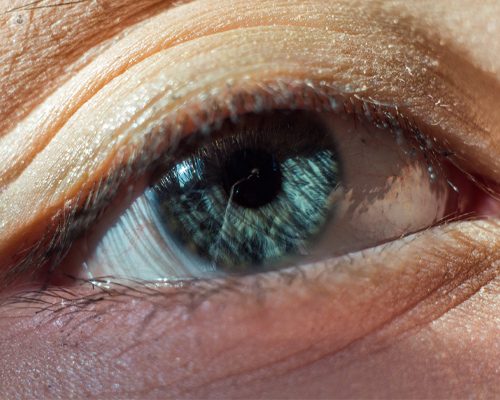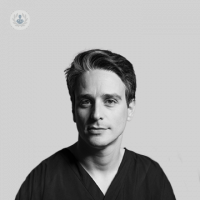Ptosis: What distinguishes it from other eye conditions?
Escrito por:The clinical nuances involved in recognising ptosis are very important when it comes to considering the condition, how it’s caused and options regarding repair.
Leading ophthalmic and oculoplastic surgeon, Dr Nick Koutroumanos speaks to Top Doctors about these issues as well as the difference between ptosis and hooded eyes, and the management of ptosis in children.

What is ptosis?
When people refer to droopy eyelids, they may be describing a number of different things which, in clinical practice, actually vary. They vary both in terms of what causes them and more importantly, how they ought to be repaired.
Eyelid ptosis or blepharoptosis, is in a sense a true eyelid droop, and it refers to the condition when one or both upper eyelids sit in a position lower than normal, whatever this normal might be for every different person. By eyelid, here we refer to the curved edge of the upper lid where the lashes are found and the area which wipes the eye’s surface every time we blink.
What causes ptosis?
The causes of ptosis form a long list and a vital part of the assessment with an oculoplastic specialist is working out which of these actually causes someone's droopy eyelid. Individuals can be born with a droopy eyelid on one or both eyes. In these cases of congenital ptosis, it is actually quite common for both eyes to be affected but to a different degree.
If you are not born with eyelid ptosis but have instead developed it later in life, chances are you have what we refer to as aponeurotic (or involutional) ptosis, which in effect refers to the gradual stretching and slipping of the little muscle which controls the eyelid position. This is common and is easily addressed by day case surgery. Correction is proven again and again to be associated with significant improvement in people’s quality of life. A droopy eyelid can of course affect one’s vision if severe enough but even in milder cases, headaches may develop due to the constant eyebrow lifting and of course, confidence is frequently affected.
A very small proportion of individuals will develop eyelid ptosis due to an underlying medical condition or injury and though these cases are uncommon, it is vital that they are identified and, when necessary, managed promptly.
What is the difference between ptosis and hooded eyes?
This is a good question because this distinction is very important to make. Hooded eyes, or dermatochalasis, is when the upper lid’s curved edge, (lash line) is sitting on an appropriate and symmetric position in front of the eye but the skin above it, is excessive. This can have many appearances, from skin hooding, hiding part of or the whole eyelid, to a bulging, bulky swelling giving a swollen eyelid appearance and so on. People describe puffy, hooded, droopy or fatty eyelids. Much like with eyelid ptosis, hooding can be distressing and disfiguring. Individuals are often thought of as being tired and can appear more aged than they feel.
When more severe, dermatochalasis or hooding can cause headaches or reduction of peripheral vision. Upper eyelid blepharoplasty surgery, when carried out by eyelid specialists is safe and rapid, a day case or sometimes in-office procedure which can dramatically improve one's youthfulness and appearance.
What is the best treatment option for ptosis?
As mentioned previously, the first and most vital bit here is making an appropriate diagnosis. Ptosis can be missed during your average non-specialist aesthetic assessment and this sometimes leads to blepharoplasty surgery being carried out inappropriately with disappointing results.
When eyelid ptosis is picked up, certain measurements carried out will define the suitability and need for surgery but also the ideal technique. If not all, the vast majority of eyelid ptosis carried out in my practice is done via a hidden incision or no incision at all, meaning that no scar is visible after surgery. An assessment of the eyeball and the eye surface will decide how safe ptosis surgery is. The need for one or both eye surgery will be assessed so that symmetry can be optimised.
Though any surgeon’s main focus will be the safety of the eye and its function, detailed attention should be given to restoring and improving symmetry and youthfulness.
What are the complications of ptosis surgery?
When ptosis and its causes are suitably worked out and the correct management plan is offered, ptosis repair surgery is a very safe procedure. Most often, it is carried out under local anaesthesia with an administration of a relaxant to ensure that the procedure is pleasant. Down time is usually about a week.
A very small proportion of patients, in the range of 5 to 10 per cent, may be offered some adjustment for refinement of the symmetry or the resulting eyelid position. Dry-eye sensation can be encountered for a number of days or weeks after surgery and a very small proportion of cases may experience longer periods of dryness. This, however, is very uncommon.
How is ptosis managed in children?
Ptosis repair in children can be both more challenging but also often more beneficial.
Depending on the severity of the droopy eyelid, the effect it causes on the child’s vision, head posture and psychosocial wellbeing, surgical correction can be offered. Congenital ptosis repair is an area of medicine of particular interest to me, given not only the technical precision required to deliver a precise result but also the incredible effect this intervention can have on a child’s quality of life and development.
A variety of surgical techniques are available all of which are carried out under general anaesthetic. The choice of technique is based on the child’s age, severity of ptosis and the strength of the eyelid muscle. Maintaining the safety of the eyes and providing a lasting natural and functional outcome is kept central to any treatment carried out.
If you’re concerned about ptosis and would like expert advice and treatment, speak to Dr Koutroumanos. Get in touch via his Top Doctors profile here.


